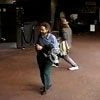Created for the Kansas City Performing Arts Center as part of the 1997
SEAMUS Conference
Audience Participation
and Response in Movement-Sensing Installations 2000 |
Related
Papers
Light Around the Edges is a sound/video installation that uses a video
camera to detect
location and movement of people in a large public space. The sensing
camera is placed
high above the audience, pointed downward at an angle. Movement on
the ground is
transmitted as numbers into the Max programming environment via David
Rokebyís
Very Nervous System (Rokeby, 1995). There, software interprets data
representing
playersí speed and location to create original music or to triggers
individual sound
samples. While participants hear the results of their actions, they
simultaneously see
themselves in the form of a processed and abstracted video projection.
Except for four speakers, the installation is invisible. Any number
of people may walk
through the sensing area, often just passing by. Any number of spectators
can watch
players dance or move around the space. As the number of participants
grows, the ability
of an individual to perceive direct impact on the system is reduced.
To meet the challenge
of accommodating an unknown quantity of players, the installation operates
in three
different modes, based on how many people are playing. Each mode defines
a sonic
environment and a lever of interaction appropriate for the number of
players. For one to
four players, the software is highly interactive, with speed and location
perceived as
having an immediate and obvious impact on the sound, generating music,
processing
sound, and controlling panning. With five to ten players, the perception
of immediate
interaction is lessened, and the space transforms into a soundtrack
of a train station, with
playersí locations triggering conversations in many languages, train
doors opening,
announcements, and the sounds of trains coming and going. Thus, the
space becomes an
invisible set, defined architecturally in sound, with fixed locations
on the floor
representing specific sounds and functions (although not entirely predetermined).
Finally,
with too many players to identify any individualís input, the third
mode turns the space
into a big party, with movement triggering canned laughter, sounds
of people eating,
conversations, glasses clinking, and other crowd sounds. The effect
is a fortified social
space, where the audienceís movements alter their own social interactions
in real time.
All three modes are playful environments that encourage conversation,
eye contact, and
movement between players and spectators, companions and strangers.
The participants
are the subject of this work, their actions, responses, facial expressions,
bodies, and social interactions are much more significant than the actual
visual and sonic material they
generate.


